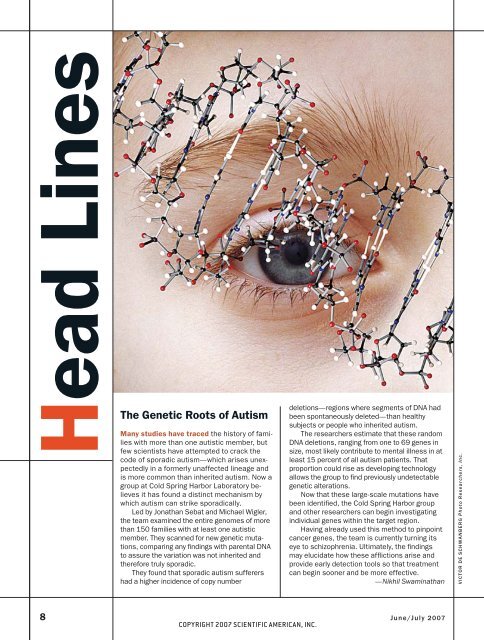Scientific American Mind-June/July 2007
Scientific American Mind-June/July 2007
Scientific American Mind-June/July 2007
Create successful ePaper yourself
Turn your PDF publications into a flip-book with our unique Google optimized e-Paper software.
Head Lines<br />
The Genetic Roots of Autism<br />
Many studies have traced the history of families<br />
with more than one autistic member, but<br />
few scientists have attempted to crack the<br />
code of sporadic autism—which arises unexpectedly<br />
in a formerly unaffected lineage and<br />
is more common than inherited autism. Now a<br />
group at Cold Spring Harbor Laboratory believes<br />
it has found a distinct mechanism by<br />
which autism can strike sporadically.<br />
Led by Jonathan Sebat and Michael Wigler,<br />
the team examined the entire genomes of more<br />
than 150 families with at least one autistic<br />
member. They scanned for new genetic mutations,<br />
comparing any fi ndings with parental DNA<br />
to assure the variation was not inherited and<br />
therefore truly sporadic.<br />
They found that sporadic autism sufferers<br />
had a higher incidence of copy number<br />
deletions—regions where segments of DNA had<br />
been spontaneously deleted—than healthy<br />
subjects or people who inherited autism.<br />
The researchers estimate that these random<br />
DNA deletions, ranging from one to 69 genes in<br />
size, most likely contribute to mental illness in at<br />
least 15 percent of all autism patients. That<br />
proportion could rise as developing technology<br />
allows the group to fi nd previously undetectable<br />
genetic alterations.<br />
Now that these large-scale mutations have<br />
been identifi ed, the Cold Spring Harbor group<br />
and other researchers can begin investigating<br />
individual genes within the target region.<br />
Having already used this method to pinpoint<br />
cancer genes, the team is currently turning its<br />
eye to schizophrenia. Ultimately, the fi ndings<br />
may elucidate how these affl ictions arise and<br />
provide early detection tools so that treatment<br />
can begin sooner and be more effective.<br />
—Nikhil Swaminathan<br />
8 <strong>June</strong>/<strong>July</strong> <strong>2007</strong><br />
COPYRIGHT <strong>2007</strong> SCIENTIFIC AMERICAN, INC.<br />
VICTOR DE SCHWANBERG Photo Researchers, Inc.

















